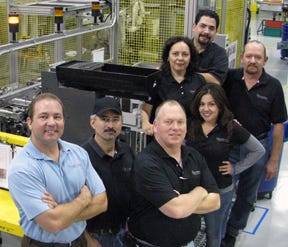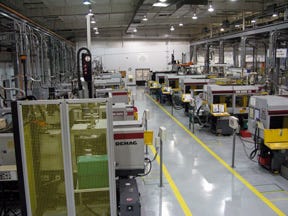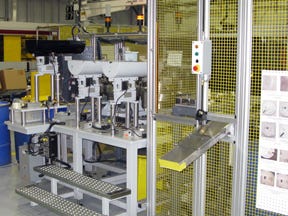GW Plastics came to Tucson, AZ in 1995 to support a growing medical customer base and customers that had set up operations in Juarez, Nogales, and Tijuana, Mexico, as well as California. Since then, Tucson has become one of GW’s premier operations.
February 16, 2011
GW Plastics came to Tucson, AZ in 1995 to support a growing medical customer base and customers that had set up operations in Juarez, Nogales, and Tijuana, Mexico, as well as 
California. Since then, Tucson has become one of GW’s premier operations.
From its headquarters in Bethel, VT, GW Plastics came a long way to serve its medical customers in the Southwest when it opened a facility in Tucson, AZ. The first time IMM visited GW’s then-new plant in Tucson nearly 15 years ago, the 70,000-ft2 facility seemed cavernous. It had just a few presses and little else. By this past October, a second tour revealed that GW Tucson had grown dramatically. Today the facility contains 40 injection molding machines, 18-650 tons, with the 50- to 300-ton range the company’s “sweet spot,” explains plant manager Michael Mims.
|
GW Plastics’ Tucson operation focuses on customers in the surgical instrument, IV therapy, life sciences, and healthcare consumables markets, and strives to be a “single-source partner” to customers, providing total support from concept to market. Locating just 1.5 hours’ drive north of the Arizona/Mexico border was intentional—to serve medical customers with plants in Nogales and other Mexican border cities. The geographic niche has proved to be a good one for GW.
While precision molding is the company’s core competency, GW Plastics also provides product development, contract manufacturing, and mold manufacturing services. The plant’s market mix consists of medical (75%), automotive (20%), and consumer and industrial applications (5%). GW Tucson runs mostly complex medical components, along with some “safety critical” automotive components. Overall, two-thirds of GW Plastics’ global revenue comes from the healthcare market segment.
Metrics are prominent
GW Tucson has two primary manufacturing areas within its facility, one compliant with ISO 14644 Class 8 requirements (formerly Class 100,000) and the other an environmentally controlled white room. GW built the cleanroom in 2009. Prior to that expansion, all molding occurred on the main production floor, which comprises 20,000 ft2 and contains 31 presses.
As we enter the main production floor area, GW Tucson’s performance metrics board is the first thing we see. It provides an instant snapshot of what happens on the floor, including operational performance measurements, customer feedback scorecards, and a display of the facility’s Six Sigma improvement projects and kaizan events. Next we come to the dressing room, where employees gown up before entering the clean environment.
There are four rows of injection machines, and as we move down the aisles, the tonnage increases from the smallest at 18 tons to the largest at 650 tons. A Mattec real-time production monitoring system records key metrics on each press, with computer screens mounted in front of each machine. The system lets employees understand their performance and react accordingly, allowing for accountability, responsibility, and ownership. GW Tucson also employs a “good catch system” to acknowledge and reward employees for either exceptional performance or strong improvement. “We try to use carrots, not sticks,” says Mims.
Each machine has a stainless steel workstation with additional lighting available for part inspection. Product quality requirements and representative samples are posted at each workstation, along with job-specific work instructions. “We try to make part quality very simple and very clear,” explains Joe Ruiz, production manager, who joins us on our tour. “All employees should know what the job requires and what constitutes a good or bad part.”
Presses are equipped with automation, including pick-and-place robots. Automation is used throughout GW Tucson to reduce part handling and provide value through waste elimination. “Most of the presses run automatically, and only require a person to change part handling totes once every two hours,” explains Ruiz.
As we continue through the main production area, there are RJG terminals monitoring cavity pressure, and vision systems to inspect and measure parts after molding. If there is a problem in the process, the equipment automatically moves the parts to a reject area away from the acceptable product.
Everything through the entire production process is monitored, including machine efficiency, mold and equipment maintenance, machine downtime, and production quality. “A strong focus of our business is good manufacturing practices [GMPs] built on a lean foundation,” adds Ruiz.
A through-the-wall overhead conveyor system takes finished goods/packaged parts to labeling and final audit prior to shipping. Every box receives a bar code label that provides full traceability of all materials and parts. Once labeled, boxes are inventoried and ready to ship. Many boxes wear a proud “ship-to-stock” label signifying an exceptional quality history, to the point that GW’s customer considers incoming inspection unnecessary.
A Motan central drying system with a press number on each dryer and a material conveying system serve to automate material handling. The material handling area is as organized and clean as the production floor—no pellets on the floor and no empty boxes lying around; it appears to manage itself.
The cleanrooms are the next stop and, looking through the glass wall from outside, we notice the product handling conveyor coming out of the wall. There is a stream of air escaping around the conveyor belt from the positive pressure in the intermediate room. The cleanroom is kept at a higher pressure to ensure no particles enter the room, and there is an intermediate room between the cleanroom and warehouse for a protection barrier. A single gowning room allows employees to enter either the molding cleanroom or the assembly cleanroom. The molding cleanroom houses nine machines with the same standardization and 5S controls as on the main production floor.
The company’s latest investment is a new clean assembly room built for molding value-add and finished packaging. In addition to molding them, GW packages the customers’ products, manages the outside sterilization requirements, and provides shipping, logistics, and supply chain management controls.
Other investments in 2010 included a new molding machine in September, two in October, and four installed in December; an 18-ton micro machine to meet customer demand for miniature parts is included in the capacity expansion. The ISO Class 8 molding cleanroom was opened in December 2009, and now houses nine machines, including three verticals for catheter overmolding, running 24/7.
Quality is under control
In 2010, bad parts at GW Plastics averaged less than 50 ppm, and on-time deliveries were 99.4%. To ensure high quality, GW employs a number of technologies for both premolding and postmolding control. Cavity pressure transducers along with machine SPC monitoring ensure that the plastic is behaving during the process. After parts are molded, the company uses vision systems for automated inspection at the machine and SQC dimension monitoring in the quality lab.
“In the quest for zero-defect manufacturing, we must ensure we reduce and control variation in the molding process,” explains Glenn Goodberlet, GW’s quality manager. “Our extensive use of automation makes this possible. We know the parts are good because the process was validated, our process controls ensure that the validated process is in effect, and the machine SPC, along with cavity transducers and vision systems, ensure the outputs remain stable.
“Finally, just to make sure, our dimensional SQC in the quality lab verifies that the parts are not only in specification, but that our process is remaining in control as well. Our next step will be to tie in all of our software systems in order to then combine process monitoring with production monitoring and quality control in one software foundation,” Goodberlet adds.
GW holds kaizan events and practices Six Sigma continual improvement. A quality feedback system with customer alerts keeps GW on its toes when it comes to quality control. Process validation plus process control is key to the company’s quality. There are setup books for the mold technicians, and process books for process technicians to ensure that every mold is set up and processed according to prior validation procedures.
The QA lab is fully equipped, including a vision system CMM and a probe CMM, things that every lab in each of the company’s plants have. GW Tucson has five tooling technicians, four of them journeyman moldmakers, who do all the mold preventive maintenance and repair. “We like to ensure that our molds stay in ‘as-built’ condition,” says Mims.
GW also surveys its customers annually through a third party to find out where the company is doing well, and where there may be areas needing improvement. “High quality and competitive costs are a prerequisite for our customers,” says Goodberlet. “We also need to make sure we add extra value and ensure all of the stakeholders are happy with our performance. This is where our customer surveys come into play.”
Employees
With the growth that GW Tucson is experiencing—and the added equipment—comes the need for additional talented team members. “We have high standards for talent and we take our time finding the right people,” Mims says. “Sometimes this takes a little longer than we would like when experiencing fast growth, but the difference between hiring a person and hiring the right person is huge.”
Training is a big part of GW Tucson’s strategy to become a single-source supplier to its medical OEM customers. “It’s people that make our company great,” says Mims. A “Bright Idea” reward system encourages employees to look for new ways of doing things to improve the company’s performance, save time and money, or just make GW a better place to work.
G
W Tucson employs approximately 100, and tracks job satisfaction annually to make sure everyone is moving forward. A company peer recognition system is a way GW’s employees give monthly rewards to those coworkers who show exceptional initiative in problem solving and other areas. At daily information meetings called “huddles,” teams talk about the most critical jobs running, recent performance, high-risk processes, and other aspects of the job. Every employee is responsible for cleaning his own area in a visible 5S work environment.
“It’s part of the idea of ownership,” Joe Ruiz notes. “Manufacturing systems should be very simple and very visible. It’s pretty easy to spot a facility where the people take pride in what they do. The opposite is also true.”
Being close to Mexico doesn’t mean GW Tucson can’t be competitive. “We can compete with low-labor-wage facilities because our processes have minimal direct labor. Our wage expenses are driven mainly by our support systems, primarily engineering and related functions,” states Mims. “Molding is not labor intensive, but assembly is. Through our manufacturing flow, automated material handling, automated production, and conveyor systems, we take out a lot of labor. We invested a lot of money in this facility so that we could be prepared to be the best there is in the Southwest and compete even within close proximity to Mexico.” —Clare Goldsberry
Vital Stats
GW Plastics, Tucson, AZ
Facility size: 70,000 ft2 total (includes 20,000-ft2 white room, 7000-ft2 Class 8 cleanroom, and warehouse areas)
Markets served: Medical; some safety-critical automotive components
Parts produced annually: 80 million from 470 different part numbers
Materials processed: Nylon, LCP, acetal, PC, ABS, PVC, PP, PE, acrylic, PUR, PEI, PS, TPE
No. of employees: 100
Work hours: Four shifts, seven days/week
Molding machines: 40 (37 horizontal, three vertical), 18-650 tons; Engel, Milacron, Sumitomo Demag
Molding technology: Insert molding, micromolding, overmolding
Secondary operations: Pad printing, inkjet printing, heat stamping, ultrasonic welding, catheter tipping, skiving, assembly
Other services: Industrial design, program management, supply chain management, sterilization management
Internal moldmaking: No; maintenance and repair are performed
Quality: ISO 9001:2008, ISO 13485, and TS 16959 certified
Top GW’s primary molding production floor comprises 20,000 ft2 and has 31 presses. Middle Employees review the performance metrics board at the entry to the main production floor, a clean environment. Above Inspecting medical parts at one of the molding cells.
This flange molding cell is one example of the automation used extensively by GW Tucson to improve quality and reduce handling of parts.
Left Production team members gather at a flange automation molding cell. Teamwork and training make for quality-oriented contract manufacturing. Below GW Tucson’s 70,000-ft2 facility is near Tucson International Airport.
About the Author(s)
You May Also Like








